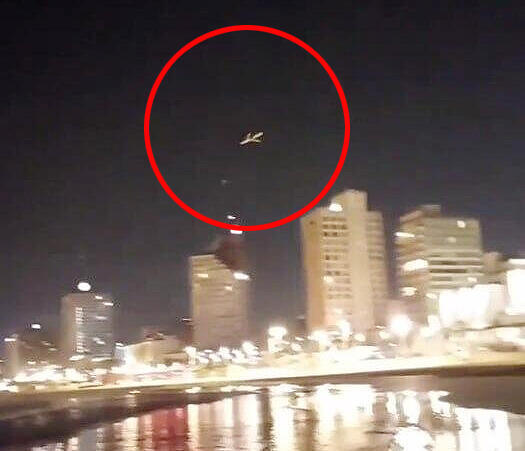
Hezbollah's UAV infiltrations expose IDF's vulnerabilities
From Yemen to Lebanon, the expanding UAV threat to Israel has the IDF strengthening defenses amid escalating tensions.
The IDF's fight against Hezbollah and terrorist UAVs in the region continued this weekend when a Navy warship intercepted a UAV launched by the terrorist organization from Lebanon. The UAV entered Israel's economic waters. The IDF suspects that it was launched towards the Karish gas rig located about 90 km from the coast of Israel and owned by British energy company Energean. The IDF has started an investigation to determine whether the launch of the aircraft was intended to photograph or attack the rig.
The interception of the UAV came against the backdrop of threats made last week by the Houthis in Yemen, who claimed they would damage Israel's energy assets in response to an Air Force attack on the port of Hodeidah last Saturday. This attack targeted infrastructure in the port and fuel depots, following the launch of an explosive UAV toward Tel Aviv that caused the death of a civilian and wounded ten others. The Houthis threatened to hit targets deep within Israel.
In response to these threats and the lessons learned from the failure of the air defense system to intercept the UAV launched toward Tel Aviv, the air and sea forces have increased patrols, particularly near natural gas rigs. The Iron Dome detected the UAV on Saturday and launched an interceptor towards it. The IDF clarified that at no point did the UAV endanger the rig and that the interception was carried out at a significant distance from it.
Hezbollah has long targeted Israel's gas rigs. Its leader Hassan Nasrallah has previously threatened to attack them in a future conflict with Israel. At the beginning of 2022, the Air Force and the Navy intercepted three UAVs launched towards the Karish rig amid negotiations between Israel and Lebanon mediated by the U.S. on the maritime border.
The increase in threats to the rigs could adversely affect Energean, which, along with Karish, also owns the Leviathan reservoir, located about 120 kilometers off the coast of Haifa. At the beginning of the war, Moody's announced that it was considering lowering the credit rating of the Israel Electric corporation and Energean due to the risks of fighting in the north. Additionally, the IDF shut down activity at the Tamar field, located about 25 km from the shores of Ashkelon, due to its proximity to Gaza and the fear of potential attacks.
However, not every UAV intrusion into Israel's airspace ends in a quick interception. Almost ten months into the conflict, the IDF is still facing challenges in detecting and identifying these aircraft. Hezbollah and other organizations are exploiting these gaps to harm Israel offensively and psychologically.
Last week, Hezbollah released footage of the Ramat David air force base, taken by a UAV that infiltrated deep into Israel and circled over the base. The UAV captured images of runways, jet fuel tanks, Iron Dome batteries, F-16 hangars, Apache helicopters, ammunition depots, and pilot quarters. For an intelligence officer, these photographs are invaluable.
Hezbollah claimed that the UAV that photographed the Ramat David base was of the "Hudhud" type. It flew over the base undetected for many minutes. Similar UAVs have been launched in recent months to other sensitive areas in northern Israel, documenting seaports in Haifa Bay, the navy base, Rafael's factories, many IDF bases in the Golan Heights, and sites where components related to air defense systems are deployed.
The IDF only learned about these photo flights after Hezbollah released the images to boost its standing in Lebanese public opinion. These capabilities demonstrated by Hezbollah should concern IDF commanders. An organization that can infiltrate a UAV with a camera into Ramat David base might next use an armed UAV or a suicide UAV. The IDF continues to struggle to close detection gaps in the north, where topographical conditions allow Hezbollah's drone operators to exploit "dead areas" not picked up by IDF detection systems. Hezbollah is building a broad bank of targets in Israel, preparing for potential large-scale attacks.
On a different front, the air defense system suffered a tragic failure when a Houthi drone launched from Yemen managed to travel over 2,000 kilometers to Tel Aviv. An Air Force investigation revealed that the failure resulted from a human error, classifying the Yemeni UAV as non-threatening. This error led to no attempts to intercept it or alert Tel Aviv of the intrusion. The detection systems were functioning correctly, as the Yemeni UAV appeared on control screens several times, including one instance for six minutes. If not for the error, it would have been intercepted earlier.
The lessons from the Tel Aviv drone explosion prompted immediate actions, including increased air patrols, more personnel monitoring control screens, and strengthening detection positions. Police teams have been analyzing the Tel Aviv strike site to gain insights, assuming similar events might occur in the future. The UAV, of the Samad type 3, exploded between two residential buildings, killing a civilian in an upper floor of a nearby building. The drone's early morning explosion, when the streets were relatively empty, prevented a larger disaster.
The rapid rise of UAV threats in global conflicts over the last few years has highlighted the IDF's partial preparedness. Many measures to improve defense against UAVs were ordered too late, only in the context of the current skirmish with Hezbollah. Efforts to close gaps include rapid procurement of means to improve detection capabilities of UAVs with low radar signatures. The procurement since the war's outbreak amounts to over a billion shekels invested in defense industries.
In a recent article by the Begin-Sadat Center for Strategic Studies at Bar Ilan University, Brigadier Generals (res.) Ran Kochav and Eran Ortal highlighted the need for more than just quick procurement. They argued that reorganizing the air defense strategy, especially on the front, is crucial. They warn that relying solely on intelligence without dynamic management will lead to waste and lack of success.
While the Air Force dominates the Middle Eastern skies, a new "low sky layer" has emerged, inviting enemy UAVs. Kochav and Ortal stress that dealing with this new reality requires more detection, tracking, identification, and faster decision-making based on real-time information. Hezbollah's presence in Israel's skies allows significant damage to key air defense components, making them more vulnerable.
The enemy continuously refines their means and techniques, using varied tools to overcome air defense systems and hit targets. Rapid learning, effective organization, and practical preparation are essential to counter this threat. This includes closing gaps in air defense protection, hiding critical infrastructure, and deceiving the enemy with dummy targets.
Establishing an additional interception layer for "point protection" will improve the defense of essential sites. This new layer will launch interceptors only if other layers fail, providing a last line of defense for facilities like power plants and Air Force bases. Re-establishing a tactical defense system for the front, based on short-term interception measures, is also recommended. This system, previously used by the IDF's anti-aircraft forces in the northern sector, was closed about 15 years ago when Rafael delivered the first Iron Dome batteries. A tactical defense array would reduce the number of UAVs penetrating Israeli airspace near the front, allowing other defense systems to focus on those that breach the "front wall."
These proposed changes will require significant conceptual, operational, and organizational adjustments in the air defense system, along with resource allocation. Acknowledging that air superiority is no longer absolute is dramatic. The "low skies" have become a real threat, and without a tactical defense system at the front, air superiority remains incomplete.















